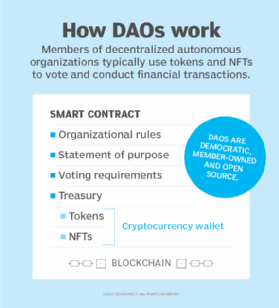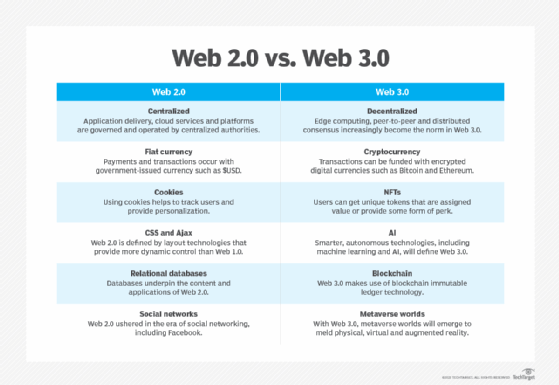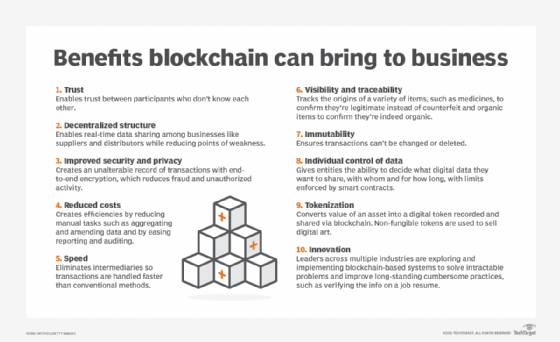The 10 most promising tools for Web 3.0 development
Web 3.0 doesn't exist yet, but there are many tools for developing apps for the next generation web and bridging the gap from today's Web 2.0 infrastructure.
The Web 3.0 landscape encompasses a complex array of interconnected tools, applications and frameworks, all of which can help bridge the current version of the web, which is often referred to as Web 2.0, and next-generation Web 3.0 infrastructure.
It's important to determine the goals of a project before selecting a set of tools. Web 3.0 technologies promise to solve numerous problems involving payment, decentralized supply chain applications and new business models more efficiently than classic World Wide Web technologies. Setting specific goals can help development teams create a shortlist of the right tools, libraries and apps.
Experts shared the following advice on how to choose Web 3.0 tools for a development project.
Take advantage of trends
Several trends are driving Web 3.0 applications that show promise in solving real business and consumer problems, according to Abhishek Singhal, a managing director at Deloitte Consulting. They include the following:
- Metaverse apps can support events, social media, commerce, marketing and branding.
- Non-fungible tokens (NFTs) can support and monetize the creator economy, in which individuals sell their creations and services on the web.
- Cross-border payments can work more efficiently.
- Process optimization can use smart contracts to bring efficiency to real estate, financial transactions and legal processes.
- Fractionalization of illiquid assets can drive liquidity and help democratize investments.
- Decentralized verification of certificates can improve automation of the hiring process.
- Low-code and no-code development platforms can hide the complexity of using blockchains and cryptocurrency wallets, two fundamental technologies in Web 3.0.
- Decentralized autonomous organizations (DAOs) can raise funds for startups and other projects.

Identify top categories
Every Web 3.0 developer is going to construct their own way of analyzing the field based on their needs. For example, Thomas Aslanian, product and token lead at Immutable, a Web 3.0 game developer, has found it helpful to consider security tools, developer experience tools, data oracles (lines of code that connect data in the real world to agreements on blockchains) and wallets. Security tools can help prevent malicious behaviors and hacks on smart contracts. Aslanian has found that OpenZeppelin, a vendor of cryptocurrency cybersecurity products and services, has a great set of tools and templates for most of a developer's key security concerns.
This article is part of
What is Web 3.0 (Web3)? Definition, guide and history
Developer experience tools can help to get up and running faster. For example, Alchemy can simplify the smart contract development process.
Data oracles like Chainlink can make it easier to get and use data in a blockchain decentralized app (blockchain dApp). Aslanian has found that wallets like Argent, ZenGo and Ledger Wallet can also help store secure financial information.
Consider the infrastructure
Michiel Oudakker, founder and strategist at About Multi-stakeholder Strategy Development, likes to break the field into different types of infrastructure. This framework makes it easier for developers to create dApps that are not controlled by any central party, according to Oudakker. The various kinds of decentralized infrastructure include the following:
- storage tools, including InterPlanetary File System (IPFS) and Filecoin;
- compute platforms, which include Ethereum and Solana;
- identity tools like Serto, Veramo and Sidetree;
- exchange tools, such as Uniswap and Sushi that help to trade assets; and
- decentralized finance (DeFi) tools, which support a variety of financial transaction models for lending, borrowing and payments.

Start with the application
Singhal said that when developers are creating a Web 3.0 application, the tools and technology stack generally depend on what type of application is being built. He breaks the developer ecosystem into the following types of tools to consider:
- Layer 1 blockchains provide a base network and include Ethereum, Solana, Cosmos, Polkadot, Avalanche and Tezos.
- Layer 2 blockchains or sidechains extend blockchains across a wider set of use cases and include Polygon, ZK Synch and many others.
- Development tools and environments help write and test apps and include Hardhat, Truffle, Remix and Foundry.
- File storage tools include IPFS, Arweave and Filecoin.
- Wallets include MetaMask and Binance Smart Wallet.
- Identity tools help connect decentralized apps to mobile wallets and include WalletConnect, Ceramic Self.ID and Solana Wallet Adapter.
- Client libraries help interact with blockchains and include web3.js, ethers.js, and Web3Modal.
- Smart contract development tools include Solidity and OpenZeppelin.
- Remote Procedure Call connectivity helps create performant app networks and includes tools like Infura.
- Blockchain indexing tools like The Graph help find data across more extensive decentralized networks.

Popular blockchain tools
Here are 10 of the most popular Web 3.0 tools and how they fit into dApp development workflows.
1. Alchemy
Alchemy is a Web 3.0 development platform for connecting dApps to blockchains. It includes tools for NFTs, DeFi, wallets, gaming, and integrating Web 2.0 and Web 3.0 apps. It provides a complete developer platform supporting infrastructure, products and debugging.
2. Casper
Casper is a smart contract platform that supports popular Web 2.0 development languages like Rust and WebAssembly. It includes tools that help update smart contracts with bug fixes as well as new features and functionality. It is focused on enterprise use cases to help organizations adopt software development best practices, such as continuous integration and delivery for blockchain apps.
3. Chainlink
Chainlink helps developers implement decentralized blockchain oracles on the Ethereum platform. This capability helps facilitate data exchange with smart contracts that run on the Ethereum blockchain. Key features include support for reliable tamper-proof networks, connection via common APIs and pre-built oracles for various use cases.
4. Chainstack
Chainstack provides a complete set of tools to build, run and scale blockchain apps. It supports all the most popular blockchains and sidechains. It also includes various primitives to help create NFTs and deploy dApps that use decentralized blockchain storage platforms like IPFS. Network management and operations tools help scale blockchain infrastructure for large deployments.
5. Ethernal
Ethernal is an open source blockchain explorer that helps automatically synchronize apps with smart contracts running on various blockchain platforms. Contract integration capabilities also enable developers to write code that interacts with smart contracts. In addition, Ethernal provides multiple tools for instrumenting smart contract code for transaction tracing and for decoding variables used in dApps. It can also integrate with other popular tools like Hardhat.
6. Etherspot
Etherspot is a multichain smart-wallet platform that helps reduce the number of steps needed for Web 3.0 transactions, which can improve the user experience. It also supports various tools for connecting Web 2.0 apps to blockchain networks. Account abstraction is a significant feature, allowing users to execute multiple blockchain transactions with a single click.
7. Fluree
Fluree is an open source blockchain database to help developers integrate legacy data applications into a blockchain. It supports graph databases, analytics and master data management on dApps.
8. Hardhat
Hardhat is an Ethereum development environment with various tools to manage and automate recurring tasks. It allows developers to run Solidity locally and test and debug Solidity code on their laptops before deploying into live dApps. Hardhat also supports features for performing stack traces and generating explicit error messages when problems arise.
9. OpenZeppelin
OpenZeppelin provides an assortment of tools to help developers build, automate and run dApps. OpenZeppelin Contracts is a modular smart contract library that supports industry best practices, while OpenZeppelin Defender provides a secure operations platform for smart contracts.
10. Solidity
Solidity is a popular language for implementing smart contracts. It allows developers to create programs that run on Ethereum Virtual Machine, the runtime environment for executing applications on the Ethereum blockchain. Solidity also supports the Hyperledger Fabric blockchain. Developers often use some of the other tools on this list, like Alchemy, OpenZeppelin and Hardhat to help create and debug Solidity apps.







